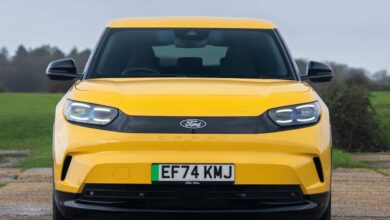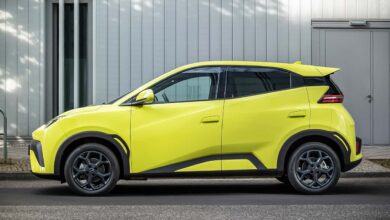Ford Isn’t Slowing Down Mustang Mach-E Production, Despite Tariffs

- The Ford Mustang Mach-E is built in Mexico, making it subject to a 25% import tariff.
- Despite that, Ford won’t be slowing down production, executives revealed Monday.
- The company needs to sell Mach-Es to hit emissions targets, so it’ll just have to do so at a loss.
Ford is one of the least-exposed automakers to President Trump’s 25% tariff on imported vehicles. There are a few big, thorny exceptions to that issue, though. There are a few big, thorny exceptions to that issue, though. The Maverick and Bronco Sport compact truck and SUV are both built in Mexico, for example. But Ford has a potentially bigger problem on its hands: The Mustang Mach-E, its most important electric vehicle, is built in Mexico too.
That means it’ll get hit with a 25% tariff. But don’t worry, that doesn’t mean Ford is going to walk away from the Mach-E. In fact, it’s not even cutting production. Asked about whether the company will trim Mach-E output due to tariff issues, Andrew Frick, president of Ford’s Blue and Model e divisions, was clear.
“It’s business as usual. We do not plan on making any adjustments [or] lowering the production,” he said during the company’s first-quarter earnings call on Monday.

16
Source: Ford
“The vehicle is doing very well right now. We actually have a very low day-supply of the vehicle itself,” he said, referring to how many days’ worth of inventory dealers have on hand. There are a few reasons why Ford won’t throttle back. First, following a bunch of price cuts from the vehicle’s initial launch, CEO Jim Farley confirmed that sales are holding up way better than internal-combustion models typically do during their fourth year on sale.
Frick also added that there’s unfilled demand in Europe, so the company can deal with some excess supply by increasing exports across the Atlantic. But that’s not the main reason why Ford isn’t slowing down. The main reason is far bigger, and a bit more technical.
Automakers are required to meet both Corporate Average Fuel Economy (CAFE) targets and Zero Emission Vehicle (ZEV) quotas to satisfy both federal and state regulations. These targets are linked to how many big, polluting vehicles you sell. So if you’re an automaker that sells a bunch of big, thirsty SUVs and trucks—like, say, Ford—you need to sell a lot of EVs to offset their emissions. If you fail to sell enough cars to meet your target, you have to buy credits from a company that comes in under the cap. The Mach-E, then, is Ford’s way of making sure it hits its emissions targets.
“It’s essential to our overall compliance,” Frick said.
That means Ford can’t pull the plug unless it can replace those EV sales with something built in the U.S. The brand’s other EV, the F-150 Lightning, is built here. But it’s a big, expensive truck, and its sales volumes are a fraction of the Mach-E’s. Long-term, Ford will surely want to build its high-volume EV models in the U.S. In the short term, though, importing the Mach-E remains Ford’s best option.
Contact the author: Mack.Hogan@insideevs.com
Source link


